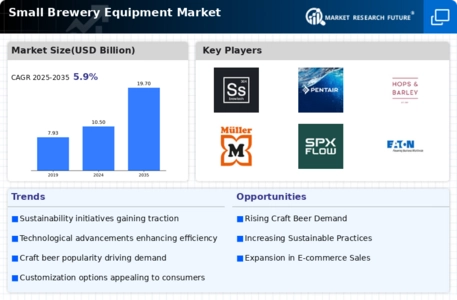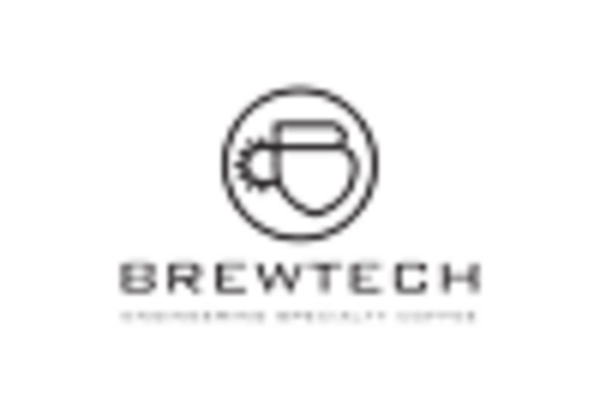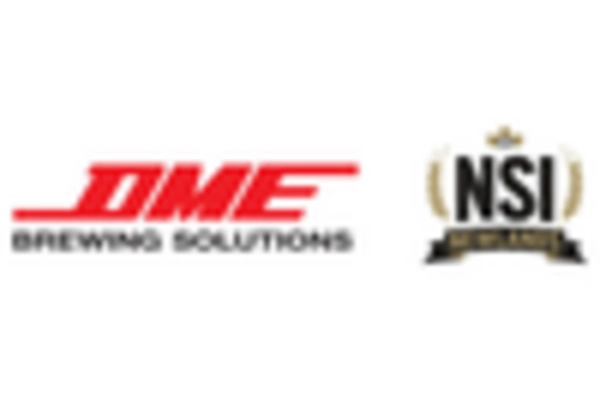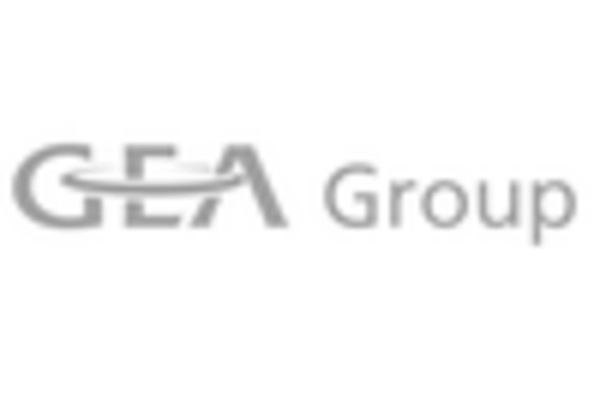Growth of Home Brewing
The rise in home brewing popularity is significantly influencing the Small Brewery Equipment Market. As more individuals take up brewing as a hobby, there is a corresponding increase in demand for small-scale brewing equipment. Recent surveys indicate that nearly 15 percent of households have engaged in home brewing, reflecting a growing interest in craft beer production. This trend not only encourages the establishment of small breweries but also drives equipment manufacturers to cater to home brewers with specialized products. The home brewing movement fosters a culture of experimentation and creativity, which may lead to the emergence of new flavors and styles in the craft beer market. Consequently, this burgeoning interest in home brewing is likely to sustain growth in the small brewery equipment sector.
Rising Craft Beer Demand
The increasing consumer preference for craft beer is a pivotal driver in the Small Brewery Equipment Market. As more individuals seek unique and locally produced beverages, the demand for small breweries has surged. According to recent data, craft beer sales have shown a steady growth rate of approximately 20 percent annually. This trend compels new entrants to invest in small brewery equipment to meet the rising demand. The proliferation of craft beer festivals and local breweries further fuels this interest, creating a vibrant market environment. Consequently, manufacturers of small brewery equipment are likely to experience heightened demand as they cater to the needs of these burgeoning enterprises.
Sustainability Practices
Sustainability initiatives are gaining traction within the Small Brewery Equipment Market. As consumers become more environmentally conscious, breweries are increasingly adopting sustainable practices, such as using renewable energy sources and minimizing waste. This shift is prompting equipment manufacturers to develop eco-friendly brewing solutions, including energy-efficient systems and recyclable materials. Data indicates that breweries implementing sustainable practices can reduce operational costs by up to 30 percent, making them more competitive. Furthermore, the emphasis on sustainability is likely to attract a broader customer base, as consumers are more inclined to support businesses that prioritize environmental responsibility. This trend underscores the importance of sustainability in shaping the future of the small brewery equipment market.
Innovations in Brewing Technology
Technological advancements play a crucial role in shaping the Small Brewery Equipment Market. Innovations such as automated brewing systems, energy-efficient equipment, and advanced fermentation technologies are becoming increasingly prevalent. These advancements not only enhance the brewing process but also improve product quality and consistency. For instance, the introduction of smart brewing systems allows brewers to monitor and control various parameters remotely, leading to optimized production. As breweries strive to differentiate themselves in a competitive market, the adoption of cutting-edge technology is likely to become a necessity. This trend suggests that equipment manufacturers must continuously innovate to meet the evolving demands of small breweries.
Regulatory Support for Small Breweries
Regulatory frameworks are increasingly supportive of small breweries, which serves as a significant driver in the Small Brewery Equipment Market. Many regions are implementing policies that facilitate the establishment and operation of small breweries, including tax incentives and reduced licensing fees. This supportive environment encourages entrepreneurs to invest in brewing equipment and start their own businesses. Data suggests that regions with favorable regulations have seen a 25 percent increase in new brewery openings. As more individuals enter the market, the demand for small brewery equipment is expected to rise correspondingly. This trend indicates that regulatory support is a crucial factor in fostering growth within the small brewery equipment sector.

















Leave a Comment